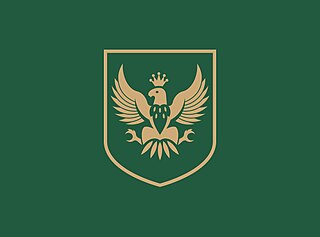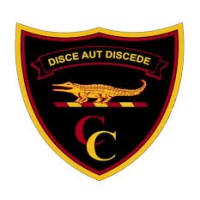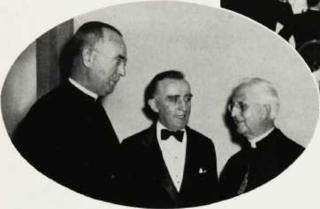
Clongowes Wood College SJ is a Catholic voluntary boarding school for boys near Clane, County Kildare, Ireland, founded by the Jesuits in 1814. It features prominently in James Joyce's semi-autobiographical novel A Portrait of the Artist as a Young Man. One of five Jesuit secondary schools in Ireland, it had 450 students in 2019.

St Ignatius College is a Catholic voluntary aided secondary school for boys aged 11–18 in Enfield, London, England, founded by the Society of Jesus in 1894 and completely moved to its present site by 1987. It was a grammar school until 1968, only accepting boys who had passed the Eleven plus exam. Former students include Alfred Hitchcock, George Martin, and Cardinal John Heenan.

Saint Andrew is a parish, situated in the southeast of Jamaica in the county of Surrey. It lies north, west and east of Kingston, and stretches into the Blue Mountains. As of the 2011 census, it had a population of 573,369, the highest of any of the parishes in Jamaica.

St. George's College is a private Jesuit boys high school in Harare, Zimbabwe. The school, colloquially referred to as Saints or George's, is located in Borrowdale, a Harare suburb. The land was donated to the Jesuits. This led to the relocation of the school site from Bulawayo to Harare, the foundation of St. George's College. On the same site, a preparatory primary school was established, called Hartmann House (HH). This site is next to the presidents house, which acts as the official Zimbabwe State House. The school motto is Ex Fide Fiducia, a Latin phrase meaning "From Faith Comes Confidence".

St Aloysius' College is a selective fee-paying, private, Jesuit day school in Glasgow, Scotland. It was founded in 1859 by the Jesuits, who previously staffed the college, and named after Saint Aloysius Gonzaga. St Aloysius' College is a co-educational school with a kindergarten, junior school, and senior school.

Jamaica College is a public, Christian, secondary school and sixth form for boys in Kingston, Jamaica. It was established in 1789 by Charles Drax, who was the grand-nephew of wealthy Barbadian sugar planter James Drax.

St. John's College is a private Catholic selective secondary school for boys and private co-educational university college, located in Belize City, Belize. Founded in 1887 by the Society of Jesus as St. John Berchmans' College, a high school for boys only, it has since grown and now offers a wide variety of liberal arts and science courses at the secondary, British A-level, and United States junior college levels.

Loyola College Prep is a private Catholic coeducational high school in Shreveport, Louisiana, founded by the Society of Jesus (Jesuits), but now operated by the Roman Catholic Diocese of Shreveport. It is among the oldest functioning former Jesuit high schools in the United States.
Dennis Patrick Ziadie was a Jamaican footballer who played in the NASL with the Boston Beacons in 1968, as well as the Jamaican national side. He is the father of fellow players Chris Ziadie, Nick Ziadie and Craig Ziadie.

Campion College is a public Catholic secondary school, located in Kingston, Jamaica. The co-educational school was founded by the Society of Jesus in 1960.
Donald George Wehby is a Jamaican business executive and former politician. Wehby is group chief executive officer at GraceKennedy Limited, and a Government senator and former cabinet minister. In September 2007, he became a senator and Minister Without Portfolio in the Ministry of Finance and The Public Service. On 5 October 2009, he returned to GraceKennedy Limited and became the company's group chief operating officer.

Cornwall College is a public high school for boys established in 1896 and located on Orange Street in Montego Bay, Saint James, Jamaica. It is the third oldest high school in the county of Cornwall. As of the 2022-23 school year, the school had an enrollment of just over 1,500 students and 80 classroom teachers, for a student–teacher ratio of 19:1.

St. Xavier’s Senior Secondary School is a private Catholic primary and secondary school located in Raj Niwas Marg in the Civil Lines area of North Delhi, in India. Founded by the Jesuits in 1960 as a residential school for boys only, the school has become a Christian minority neighbourhood co-educational school catering for students from preparatory to Grade 12. The school is recognised by the Directorate of Education, Delhi Administration, and is affiliated to the Central Board of Secondary Education for the All India Secondary School Examination and All India Senior School Certificate Examination.
Arab Jamaicans refers to Jamaican citizens of Syrian, Lebanese and Palestinian Arab or partial Arab origin or descent. Most are Christians who arrived in the late 19th century, having fled their homeland due to religious persecution under Ottoman rule.

Thomas Addis Emmet, SJ August 23, 1873 – October 5, 1950) was an American-born bishop of the Catholic Church. He served as the Vicar Apostolic of Jamaica from 1930 to 1949.

Joseph John Issa, is a Jamaican businessman and philanthropist. He is best known as the founder of Cool Group, which comprises over 50 companies.

St Xavier's Up-High School is a Co-education institution. English–Gujarati medium school, grades one through twelve, opened in 1963 and run by the Society of Jesus. in Surat, Gujarat, India.
Abraham Elias IssaOJ was a Jamaican businessman, entrepreneur and hotelier acclaimed as "The Father of Jamaican Tourism". As the first president of the Jamaica Tourist Board he contributed to the expansion of Jamaican tourism in the late 1950s.

St John's Beaumont School is a private day and boarding Jesuit preparatory school, and is for boys and girls aged 3 to 13 years old. It is situated between Englefield Green and Old Windsor on Priest's Hill, with the school building in Surrey and the sports fields in Berkshire. It was opened in 1888, and it is the oldest purpose-built preparatory school in the UK. The building is Grade II listed and was designed by John Francis Bentley in Tudor style with a Perpendicular chapel, and it was named St John's, in honour of St John Berchmans, who was canonised that year.
Winthorpe Bell was a Jamaican football manager, in honor of whom the KSAFA Jackie Bell Knockout Competition was named.

















